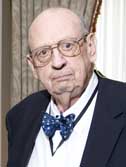1. President Emeritus Dana-Farber Cancer Institute, Physician-in-Chief Emeritus Boston Children’s Hospital and Robert A. Stranahan Distinguished Professor of Pediatrics and Professor of Medicine, Harvard Medical School
2. Blanche P. Alter, MD, MPH, Senior Clinician, Division of Cancer Epidemiology & Genetics, Clinical Genetics Branch, National Cancer Institute
Frank H. Gardner, MD, secretary of the American Society of Hematology from 1968 to 1970, died at his home in Galveston, Texas, on April 6, 2013, at the age of 93. A brilliant clinician and teacher, Frank was an inspiration to scores of medical student, residents, fellows, and young, aspiring hematologists. He was also a committed clinical investigator. Along with Scott Murphy, one of his fellows at the Peter Bent Brigham Hospital in Boston (now Brigham and Women’s Hospital) and then at the Presbyterian-University of Pennsylvania Medical Center in Philadelphia (now Penn Presbyterian Medical Center), Gardner was the first to show that platelets stored for four to five days at room temperature retain viability and function while storage at 4 degrees centigrade led to immediate removal of transfused platelets from the circulation.
Dr. Gardner, the son of a physician, was born and raised in San Bernardino, California, and went to college and medical school at Northwestern University in Chicago. His internship and residencies were in Chicago and San Francisco. He then joined the Harvard Medical School affiliated Thorndike Memorial Laboratory at the then Boston City Hospital under the watchful eyes of William Bosworth Castle and Thomas Hale Ham. Soon the neighboring Peter Bent Brigham needed a hematologist. Frank was appointed to that position and remained on the faculty from 1949 until 1966 except for two years of military service (1953-1955). During that time, he undertook rewarding research on sprue while stationed in Puerto Rico at the U.S. Army’s Tropical Research Medical Laboratory. At Brigham, his strong program produced more members of the American Society for Clinical Investigation than any other division in the Department of Medicine. Further, based on a mutual interest in the management of congenital and acquired bone marrow failure, Gardner established an innovative collaboration with Louis K. Diamond at the neighboring Children’s Hospital.
In 1966, he moved to Philadelphia where he was professor of medicine at the University of Pennsylvania School of Medicine. He found his happiest academic home at the University of Texas Medical Branch in Galveston, which he joined in 1975, remaining for 35 years until his retirement. His clinical, mentoring, and teaching skills were highly valued in Galveston. In 2011, he was honored by the University of Texas Medical Branch with the John B. McGovern Lifetime Achievement Award in Oslerian Medicine.
Those of us who had the good fortune to train with Frank were never out of his sight. We constantly received journal reprints or other thoughtful reminders from him as he watched our progress with a gimlet eye. He was proud of our achievements, but insistent that medical research, like clinical work and teaching, must focus on the patient. Through his own efforts and those of his trainees, his legacy was surely improved patient care.

